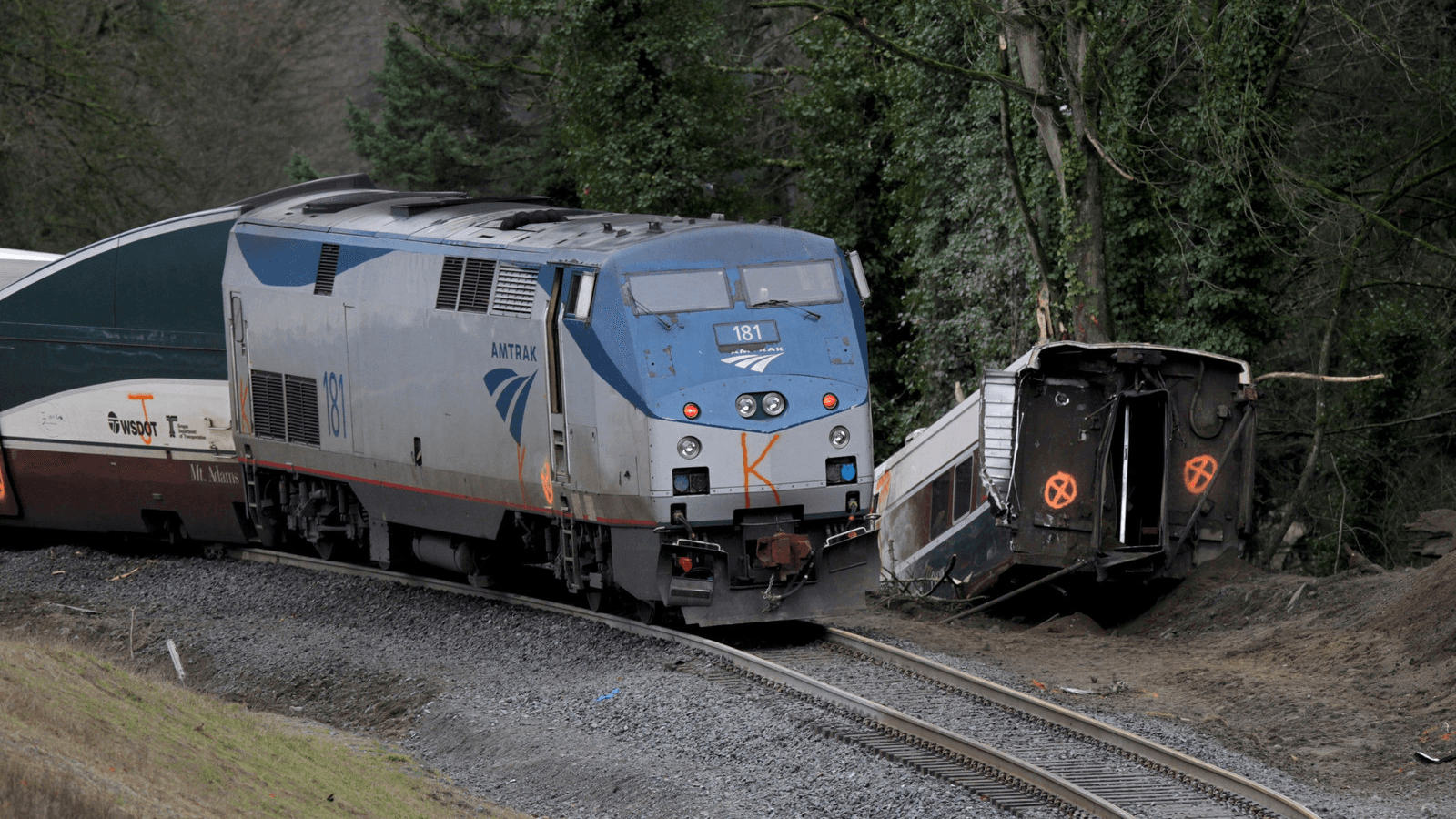Amtrak safety record already under scrutiny before fatal derailment
The scene where an Amtrak passenger train derailed on a bridge over interstate highway I-5 in DuPont, Washington, Dec. 18, 2017.
The deadly derailment of an Amtrak train south of Seattle is likely to intensify scrutiny of the national passenger railroad company's safety record, which was already under the microscope following a series of fatal incidents.
The US National Transportation Safety Board (NTSB) said late on Monday the train was traveling at 80 miles per hour in a 30-mph zone when it jumped the tracks that morning.
The NTSB said it was too soon to say whether excessive speed contributed to the crash, which killed at least three people. Another 100 were taken to hospitals, 10 with serious injuries, officials said.
Amtrak's co-chief executive, Richard Anderson, told reporters earlier on Monday he would not speculate on the cause of the derailment and said safety was the company's top priority.
However, Anderson acknowledged that a working Positive Train Control (PTC), a system that automatically slows trains if they are going too fast, had not been installed on that stretch of track. PTC also prevents train-on-train collisions and stops a train from passing through misaligned tracks.
Moreover, NTSB Chairman Robert Sumwalt just last month issued a scathing critique of Amtrak's culture, saying a future breakdown was likely.
"Amtrak's safety culture is failing and is primed to fail again, until and unless Amtrak changes the way it practices safety management," Sumwalt said on Nov. 14.
Congress had mandated the implementation of PTC nationwide by the end of 2015, then extended that deadline until the end of 2018 after finding installation was harder than anticipated.
"Every year we wait in implementing PTC to its full extent, more people are going to be killed," Bella Dinh-Zarr, an NTSB member helping oversee the derailment investigation, told CNN on Tuesday.
In 2015, the NTSB calculated PTC would have prevented 145 train accidents, saved 300 lives and avoided 6,700 injuries had it been in place since 1969.
Investigators have said speeding was to blame, at least in part, for a number of recent crashes, including one in 2015 in Philadelphia that killed eight people.
Senator Richard Blumenthal, a Connecticut Democrat, said on Tuesday that PTC was "needed now."
"Why was Amtrak train traveling at nearly TRIPLE the speed limit before fatal derailment?" Blumenthal asked in a Twitter post. "Positive Train Control might have prevented this disaster and saved lives."
Less than half Amtrak's 459 locomotives had PTC as of the second quarter of 2017, the most recent data available from the US Department of Transportation's Federal Railroad Administration (FRA).
Two-thirds of Amtrak's track segments and route miles had PTC in operation.
In Germany, Britain and France there has been some form of automatic train control since the 1930s, the FRA said. Japan has run its bullet trains since 1964 with zero passenger fatalities.
Amtrak did not respond to a Reuters query on whether the locomotive in Monday's crash had PTC. But even if it did, the tracks at the accident site, owned by the Transit Sound commuter rail, did not. To be effective, PTC must be operating both in the engine and on the tracks, with radio towers installed and staff trained in its use.
Keith Millhouse, a former chairman of the board of directors for Southern California's Metrolink commuter rail system, said the NTSB's previous criticism suggested Amtrak might be "distracted" from its safety mission.
He also questioned why Amtrak had yet to install PTC nationwide. Even though it has another year to complete the measures, the project was mandated by the US Congress nine years ago.
"Amtrak is supposed to be the national rail," Millhouse said. "Why aren't they taking the lead?"
Other railroad advocates are more forgiving, pointing to the difficulties of installing new technology on largely 20th century infrastructure, as well as chronic underfunding.
US President Donald Trump said on Twitter on Monday the accident showed why his soon-to-be submitted infrastructure plan must be approved quickly.
Earlier this year the Trump administration proposed ending subsidies for Amtrak to operate long-distance train service, cutting $630 million of the $1.4 billion in annual government support for passenger rail service. Those cuts were rejected by Congress.
"There is a money issue because while Congress mandated the implementation of PTC on the railroads, they didn't give any money for it, so it is self-funded," said Allan Zarembski, director of the Railroad Engineering and Safety Program at the University of Delaware. He added the caveat that U.S. funding for Amtrak covers its capital programs.
"For commuter agencies, it falls on the local governments to fund them," he said.
Sound Transit spokesman Geoff Patrick said PTC equipment had been installed where the crash happened, but that the system was not yet operational or certified for use. Full implementation on that segment was expected by the second quarter of 2018, he said.
